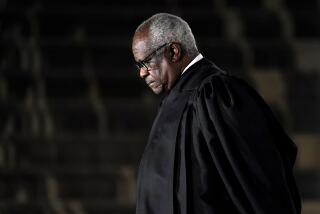Taxation’s legality is key to health reform
One afternoon in 1934, Supreme Court Justice Harlan Fiske Stone decided to quietly help Labor Secretary Frances Perkins out of a jam.
Her quandary was how to write a Social Security law that would survive scrutiny by the court’s conservative bloc. Stone, a progressive, pulled her aside during a tea party at his home, glanced around to make sure he wasn’t overheard, and whispered, “The taxing power of the federal government, my dear; the taxing power is sufficient for everything you want and need.”
As Stone counseled, the court had earlier held that the government’s taxing power was virtually absolute. And so it was that tax provisions were liberally sown throughout the bill enacting the nation’s landmark social insurance program, which handily survived Supreme Court challenge a few years later.
Nor is there any mystery why a federal tax is the hub of the federal healthcare reform act’s individual mandate, the constitutionality of which is being argued this week before the current Supreme Court. The tax is the mechanism for enforcing the mandate — if you don’t have insurance, you’ll pay a tax. Or why the court’s upholding of Social Security in 1937 has been cited repeatedly in their briefs and oral arguments by the lawyers defending the mandate, not to mention by Justice Ruth Bader Ginsburg during oral arguments Tuesday.
The tax issue pervades the judicial debate over the healthcare law, but whether Congress’ clever maneuver was enough to inoculate the act from court hostility is open to question. At least, that’s one question. You don’t have to go as far as the attack brief by a lobbying group for small business, which calls the mandate an “unprecedented … threat to individual liberty,” to understand that no act of Congress in recent times has a greater potential effect on how businesses perform, government regulates, individuals conduct their lives.
The court acknowledged the act’s importance by scheduling an unprecedented six hours of arguments on its constitutionality over three days, including a two-hour session Tuesday on the individual mandate and its associated tax penalty alone.
As befits a measure implicating legal and ideological principles so directly, the discussion was a dramatic one. Three conservatives, Chief Justice John Roberts and Justices Antonin Scalia and Samuel Alito, and purported swing voter Anthony Kennedy, worried the law’s defender, Solicitor General Donald B. Verrilli Jr., as mercilessly as dogs with a bone, leading some court watchers to declare the mandate dead.
Once the lectern was turned over to lawyers for the challengers, including the small-business group and 26 states, that wasn’t so clear. Kennedy and Roberts both indicated that they were at least receptive to the government position that healthcare is an interstate market that involves virtually every American, and is therefore ripe for congressional regulation.
“The young person who is uninsured is uniquely proximately very close to affecting the rates of insurance and the costs of providing medical care in a way that is not true in other industries,” Kennedy said. “That’s my concern in this case.”
Of course, it’s well understood that projecting the court’s ultimate decision, which won’t come for months, from the justices’ comments during oral arguments is a mug’s game. As in sports, you have to let the contest play out — sometimes Lehigh will beat Duke, after all.
Fundamental to the question of whether and how the federal government should regulate the delivery of health coverage is society’s unwillingness to let people sicken and die without care. That’s why Congress in 1986 passed the Emergency Treatment and Active Labor Act, which forbids emergency rooms to turn away patients regardless of their ability to pay.
It’s why Americans end up spending more than $116 billion a year in treatment for the uninsured, a bill that ends up being covered out of premiums charged to those who do have insurance to the tune of an average $1,000 per family policy. The figures, which are from the government’s Supreme Court brief, lie at the heart of the government’s argument that the uninsured are inextricably part of the web of interstate commerce that brings the health insurance market into Congress’ regulatory ambit.
Although critics of the healthcare law would have us think otherwise, the Supreme Court well knows that this is not the first time that Congress has taken up social welfare as a fundamental concern or fashioned an all-encompassing mandate to address it. The precedent is Social Security, which addressed a crisis of poverty among the elderly that didn’t look as if it would be going away.
Supporting the elderly was going to be society’s responsibility any way you cut it, Congress was told by Edwin Witte, the Social Security bill’s chief architect; the question was how to do it humanely, efficiently and effectively. “This growing number of old people will have to be supported,” he said, “and whether you do it in the form of pensions or in some other way, that cost is there.”
The option Congress chose was a contributory pension scheme designed to apply to every wage-earner. (The law initially left out many workers, including domestic workers, but was consistently broadened until today only a limited number of state and local government workers remain outside the system.)
As Ginsburg observed, Social Security faced many of the same criticisms laid against the individual mandate. “A lot of people said — maybe some people still do today — I could do much better if the government left me alone.... They’re forcing me to paying for this Social Security that I don’t want.” But it was constitutional.
Then, as now, the new program was seen as a novel approach to both a novel social problem and the novel recognition that social welfare had to be seen as a federal responsibility.
Social Security had been brought before the court essentially as a tax case — was the employers’ share of the payroll tax constitutional? But then, as perhaps will happen now, that issue became a springboard for a broader consideration of how law and our interpretation of the constitution must evolve to accommodate the modern world.
“Needs that were narrow or parochial a century ago may be interwoven in our day with the well-being of the nation,” wrote Justice Benjamin Cardozo, delivering the Court’s 7-2 opinion upholding Social Security. “What is critical or urgent changes with the times.... The purge of nationwide calamity that began in 1929 has taught us many lessons. Not the least is the solidarity of interests that may once have seemed to be divided.”
President Franklin Roosevelt had made that point earlier, kicking back at the court’s nullification of a key New Deal program in a decision that turned, as do this week’s arguments, on the reach of the Constitution’s commerce clause, which defines the limits of congressional authority.
“The country was in the horse-and-buggy age when that clause was written,” FDR groused. “Probably 80 or 90% of the human beings in the 13 original states were completely self-supporting.” Constitutional interpretation, he maintained, had to keep up with “present-day civilization.” That’s the heart of the debate the court will have to undertake as it digests this week’s oral arguments over the Affordable Care Act: whether it wishes to rest on principles with a reach not far beyond the 19th century, or adjust them to the undeniable realities of the 21st.
Michael Hiltzik’s column appears Sundays and Wednesdays. Reach him at mhiltzik@latimes.com, read past columns at latimes.com/hiltzik, check out facebook.com/hiltzik and follow @latimeshiltzik on Twitter.







